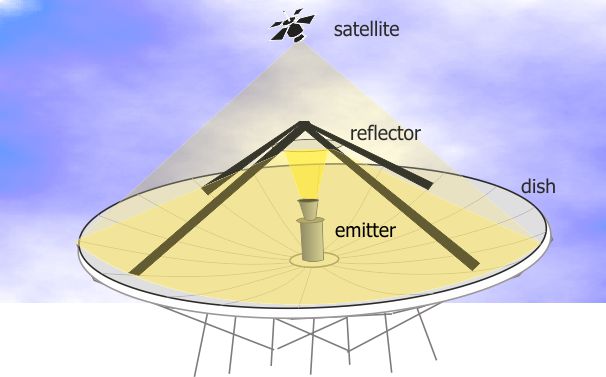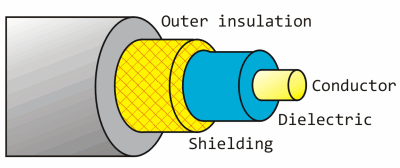Freesat reception - all about dishes
 Brian Butterworth published on UK Free TV
Brian Butterworth published on UK Free TV Satellite reception has both advantages and disadvantages compare with terrestrial (aerial) reception.
By using much higher frequencies (gigahertz, compared to terrestrial televisions megahertz) more transmission channels called transponders (the satellite equivalent of multiplexes) can be provided. For example, there are only six Freeview multiplexes, but Sky or Freesat users can access two hundred satellite transponders.
Aside from exceptional weather conditions (very heavy rain for example) digital satellite provides stable pictures and audio. Where Freeview transmitters are no more than 732 metres above sea level, the geostationary satellites used for television are 35,800,000 metres above the equator so reception is possible even where buildings, trees and hills make terrestrial reception impossible.

The downside of the transmitters being 22,300 miles up in the air is that the signals are very, very weak - so standard TV aerial is of little use. When the signals are sent to the satellites, huge dish transmitters are used to uplink the signal to the satellite. These are tens of metres from side to side, and feature an emitter that generates the signal, which is first bounced of a mirror (called a reflector) and then off the surface of the parabolic dish.

There are many satellites in the sky over the equator. Often these are in clusters over a particular position, for example there are four used for UK television are at 28.2 degrees east. There is another cluster over the 19.2 degrees east positions that are used for German television.
To receive these very weak signals from the satellite, it is necessary to use a dish for reception too. By using a reflective dish, this concentrates the signals onto a small device called a LNB. This is held in front of the dish by a metal arm.

The size of dish for reception is typically much smaller; often 60cm to 100cm in diameter, but the exact size depends upon the transmitting satellite transponder. To keep the transmission power levels down to levels that can be powered by the satellite's solar panels, each beam is focused on a particular area of the Earth's surface. If you are trying to receive the signal at the centre of this zone, a small dish is required. At the outer edges, you may need a 5 metre dish. Maps of these zones are provided by the satellite companies, and are called satellite footprints.
When the dish is installed it must be aligned carefully as the signal is very weak. The installer needs to know the inclination and the azimuth from the ground location to the satellite. If you install yourself you will find that there are markings on the dish that are used to point the dish in the correct position. It is important that the view of the satellite will not be blocked, so must take into account leaves growing on trees and potential building works.
For many people the LNB will have a single cable connected to it, however if you have Sky+ or a multi-room installation the LNB package will actually contain four receivers a quad-LNB. Unlike terrestrial television where you can split the aerial cable to feed more than one Freeview box or television set, with satelite reception you cannot. So, a Sky+ box with two receivers (so you can watch one thing and record another) has two cables connecting the box to the dish.
The cable that connects the dish to the receiver must be satellite grade cable. Whilst this looks superficially like the cable used to connect and aerial to a television, a higher grade cable is required for satellite reception.
Here is an image of a co-axial cable. This sort of cable is used to connect any type of receiving aerial to the reception equipment.

RG6, PF100 and PH100 are all types of coax cable that are suitable for the very weak signals that are received by a satellite dish. (The power is the same as you would receive from a one-bar electric heater on the moon).
The conductor in the centre passes the signals received from the dish to the set-top box. This is made from steel in RG6 cable, and from copper in the RF100 and PH100 types. This makes RG6 less suitable in the UK where rain can damage the cable.
The shielding is responsible for keeping unwanted external interference from damaging the signal. In the cheaper cable this will be a foil wrap, in better specified cables this is a braid (or mesh) of copper wires. The sheild in the RF100 covers 58% of the cable.
The non-conducting layer between the shield and the conductor is called the dielectric. This can be either a solid (RG6), foam (RF100) or air-spaced (PH100) dielectric. This makes the cables progressively more flexible (ie bendy without damage).
ChrisR: You can use either a "generic" receiver or a Freesat box. "Generic" boxes will not have the right channel numbers, the full EPG or MHEG5 text services.
| link to this comment |
11:47 AM
Briantist, I think I'll try the 'generic' receiver first and if alls ok maybe invest in a Freesat box when I go back to the UK for a visit. Thanks for your help.
| link to this comment |
8:56 AM
Briantist, I've bought a local receiver and it shows Astra 2a, b, c but when I tune it in I don't get any of the freesat channels. I've seen elsewhere the mention of Astra 2e do I need to be able to receive from this one? Also do Sat receivers have a pre determined list of satelittes or do they show what satelittes are availaible for the position of the dish?
| link to this comment |
ChrisR: There is no Astra 2C. Most of the channels are on Astra 2D. Astra 2E has not yet launched.
| link to this comment |
11:30 AM
Briantist. Do I need to get the dish moved to pick up Astra 2D?
| link to this comment |
11:55 AM
Briantist. I've just rescanned the receiver and it is indeed Astra 2D and not 2E, so I guess the dish is in the right position?
When the box is scanning I'm getting messages similar to the ones below does this mean anything to you?
10714 H 22000 Failed
10729 V 22000 Failed
there are similar messages which are ok.
| link to this comment |
ChrisR: Have you got a large dish, as you will need a larger-than-normal dish if you are outside the UK and wish to watch Astra 2D channels.
| link to this comment |
1:05 PM
Hay im trying to find out whether I can pick up freeview on a Philips terrestrial receiver in germany. I think that all the flats run off of one Satelite. Any feedback will be appreciated.
| link to this comment |
4:03 PM
Briantist.
I haven't installed the dish it looks pretty much the same as all of the other local dishes around, which I guess is the problem.
How large should the dish be?
Thanks for you help with this.
| link to this comment |
ChrisR: Can you see the "Where can I receive it?" section on the All about Freesat | ukfree.tv - independent free digital TV advice page?
This has details of the size of the dish required for Astra 2D.
| link to this comment |